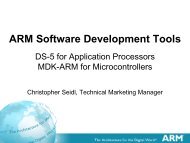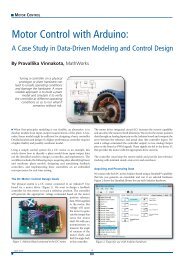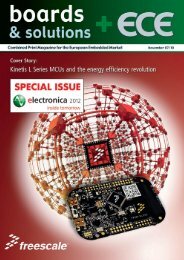AMD G-Series SOC integrates CPU, GPU and I ... - ICC Media GmbH
AMD G-Series SOC integrates CPU, GPU and I ... - ICC Media GmbH
AMD G-Series SOC integrates CPU, GPU and I ... - ICC Media GmbH
- No tags were found...
Create successful ePaper yourself
Turn your PDF publications into a flip-book with our unique Google optimized e-Paper software.
COVER STORY<strong>AMD</strong> G-<strong>Series</strong> <strong>SOC</strong> <strong>integrates</strong> <strong>CPU</strong>,<strong>GPU</strong> <strong>and</strong> I/O controller onto a single dieBy Craig Bryant, <strong>AMD</strong> Embedded SolutionsWith the introduction ofthe G-<strong>Series</strong> <strong>SOC</strong>, <strong>AMD</strong> hascompleted the process ofevolution from <strong>CPU</strong>, chipset<strong>and</strong> dedicated graphicsvia APU <strong>and</strong> controller hubto a single fully-integratedx86 building block. Whatbenefits can developersexpect from the newG-<strong>Series</strong> <strong>SOC</strong> platform? With the introduction of the <strong>AMD</strong> EmbeddedG-<strong>Series</strong> in 2011, a low-power <strong>CPU</strong> <strong>and</strong> adiscrete-class <strong>GPU</strong> was combined into a singleAccelerated Processing Unit (APU). The <strong>AMD</strong>Embedded G-<strong>Series</strong> APU resulted in a spaceefficienttwo-chip solution – comprising theAPU <strong>and</strong> a companion I/O controller hub –that offered high multimedia <strong>and</strong> parallel processingperformance on a low-power platform.With the introduction of the new <strong>AMD</strong> EmbeddedG-<strong>Series</strong> <strong>SOC</strong> platform, <strong>AMD</strong> hasbuilt on the strength of the G-<strong>Series</strong> processorarchitecture <strong>and</strong> is completing the evolutionby reducing the two-chip architecture of theG-<strong>Series</strong> APU to a single chip. At the sametime it delivers multimedia <strong>and</strong> heterogeneousprocessing capabilities that promise superiorperformance-per-watt in the low-power x86-capable microprocessor class of products whenrunning multiple industry st<strong>and</strong>ard benchmarks.Additionally, it supports enterpriseclasserror-correction code (ECC) memory.The new <strong>AMD</strong> G-<strong>Series</strong> <strong>SOC</strong>s are available indual- <strong>and</strong> quad-core variants. Featuring thenext-generation Jaguar-<strong>CPU</strong> core with 28 nmtechnology <strong>and</strong> an enhanced integrated Radeon<strong>GPU</strong> core with frequency increase <strong>and</strong> instructionsper cycle (IPC) improvement, G-<strong>Series</strong><strong>SOC</strong>s deliver up to a 113% <strong>CPU</strong> performanceimprovement compared to G-<strong>Series</strong> APUs, <strong>and</strong>a 125% <strong>CPU</strong> improvement versus Intel Atomwhen running multiple industry-st<strong>and</strong>ard compute-intensivebenchmarks. New features includeenhanced Universal Video Decode (UVD) hardwareacceleration (H.264, VC-1, MPEG 2 <strong>and</strong>more) <strong>and</strong> new video encode capabilities withenhanced clock gating <strong>and</strong> C6 deep powerdowncapabilities that lower overall power consumption.G-<strong>Series</strong> <strong>SOC</strong>s also support remotewireless display capabilities with minimal latency.Another new feature is the ECC support, which,up until now, has been limited to power-hungryprocessor platforms. However, the evolution ofa new class of ultra energy-efficient, computeintensivex86 IT infrastructure <strong>and</strong> precisioncontrol systems makes ECC an increasingly importantrequirement. The ability of the G-<strong>Series</strong><strong>SOC</strong> platform to support enterprise-class ECCmemory distinguishes it as an excellent fit forapplications requiring high levels of data integritywithout compromising energy efficiency.The integrated <strong>GPU</strong> supports DirectX 11.1,OpenGL 4.2 <strong>and</strong> OpenCL 1.2, enabling highspeedparallel processing <strong>and</strong> high-performancegraphics processing that provides up to 20%improvement over G-<strong>Series</strong> APUs <strong>and</strong> 5x improvementversus Intel Atom. Support for thesecomputing frameworks affords a host of softwaredevelopment options with advanced graphicsAPIs, while extending application lifetime therebyhelping to minimize software developmentcosts <strong>and</strong> maximize ROI. OpenCL-enabled<strong>CPU</strong>/<strong>GPU</strong> parallel processing can be especiallybeneficial to high-precision applications suchas industrial control <strong>and</strong> automation, security<strong>and</strong> surveillance, <strong>and</strong> communications infrastructure,allowing OpenCL APIs to access theintegrated <strong>GPU</strong> with 256 GFLOPs per clockcompute power. Meanwhile, seamless DirectX11 <strong>and</strong> OpenGL support complements the<strong>AMD</strong> G-<strong>Series</strong> <strong>SOC</strong> DisplayPort 1.2-enableddual independent display capability, providinghigh-resolution multi-display support for graphics-drivenapplications spanning digital signage,digital gaming, thin client <strong>and</strong> human machineinterface (HMI). On the mechanical side, theFigure 1. A complete system on a single chip:the <strong>AMD</strong> Embedded G-<strong>Series</strong> <strong>SOC</strong> platform<strong>integrates</strong> <strong>CPU</strong>, <strong>GPU</strong> <strong>and</strong> I/O controller ona single die.May 2013 6
















